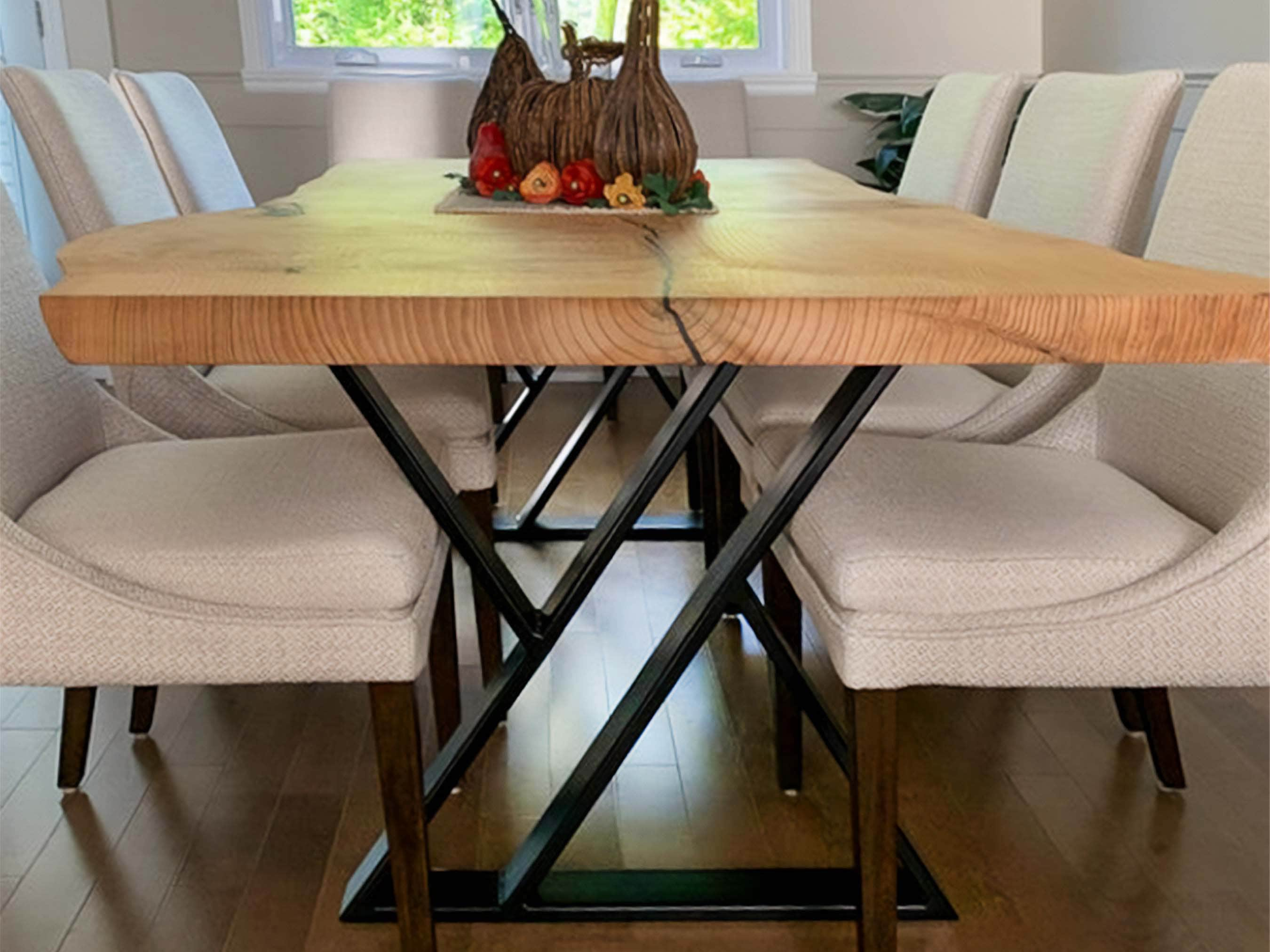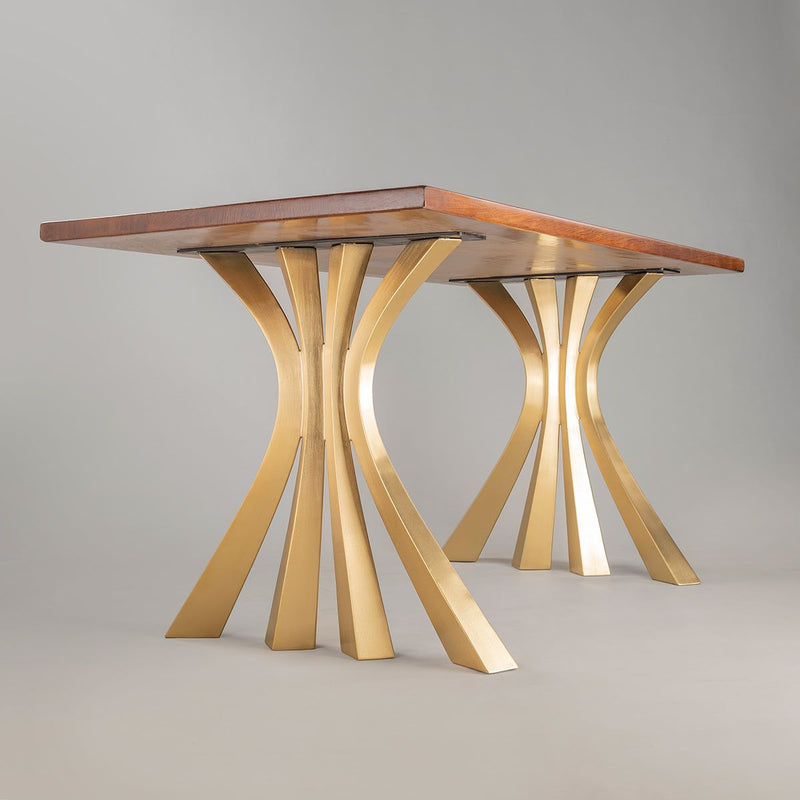A Detailed Consider Eating Table Leg Styles: Locating the Ideal Suit
Choosing the ideal dining table leg style is vital for both aesthetic appeal and functional capability. Traditional four legs use timeless beauty and stability, while the stand base supplies raised legroom and a contemporary look. For those with bigger tables, trestle legs guarantee strong assistance, whereas hairpin legs introduce a mid-century modern-day ambiance with their minimal style. The x-shaped legs mix modern style with improved stability. Each of these options brings unique advantages, making the selection more than simply an issue of preference. Discover additionally to discover which style flawlessly matches your dining room and lifestyle.
Typical Four Legs
Amongst the numerous sorts of eating table leg styles, the standard four-leg design stays an ageless option for several households. This classic setup offers an unified blend of performance and aesthetic appeals, making it a seasonal favorite. 4 legs offer well balanced assistance, making certain the table continues to be steady and with the ability of bearing considerable weight. This is specifically useful for homes that regularly host huge celebrations or use their table for numerous purposes, such as job or crafting.
From an aesthetic perspective, the standard four-leg style can be easily adjusted to numerous interior styles. Whether crafted from timber, steel, or a mix of products, these legs can be intricately sculpted, smooth and minimalistic, or anything in between. Their flexibility enables them to complement both rustic and contemporary settings perfectly.
Furthermore, the straightforward framework of the four-leg design promotes simplicity of motion and placement within a space. Unlike more complicated bases, this design minimizes obstructions, offering sufficient legroom for diners. In recap, the traditional four-leg table leg style weds enduring style with useful functionality, making it an astute selection for those looking for both form and feature in their eating furnishings.
Pedestal Base
Commonly celebrated for its stylish and space-efficient style, the stand base is a prominent option to the traditional four-leg arrangement in table leg designs. This unique base commonly includes a solitary central column sustaining the tabletop, which can differ in type, from ornately sculpted wood to sleek, contemporary steel. One of the primary advantages of the stand base is its capacity to take full advantage of legroom and seating adaptability. Without edge legs, diners are paid for better freedom of movement, making it an excellent option for round and oval tables that promote even more intimate and inclusive gatherings.
Additionally, the stand base's central assistance can manage substantial weight, enabling using much heavier table tops, such as marble or thick wood. This strength paired with its visual adaptability makes the stand base a prominent choice in both standard and contemporary interior settings. It can seamlessly incorporate with different layout themes, from timeless sophistication to minimal modernity. Furthermore, the central column itself supplies a canvas for intricate layouts and creative expressions, including an aspect of aesthetic rate of interest under the table. In recap, the stand base combines performance with style, making it a fine-tuned and useful choice for diverse eating settings.
Trestle Legs
Trestle legs provide a durable and ageless foundation for dining tables, defined by their straight cross-bracing and tough support beam of lights. Originating from medieval times, this style has progressed yet preserved its crucial framework, making it a perennial fave in both traditional and modern setups. The central trestle beam of light, commonly sustained by two or even more vertical blog posts, supplies outstanding stability, permitting for bigger table lengths without the requirement for added legs.
A substantial benefit of trestle leg tables is the adequate legroom they use. Unlike tables with 4 corner legs, the absence of obstructions at the table's sides supplies unobstructed area for chairs and diners, boosting convenience and availability. This makes trestle tables suitable for fitting bigger celebrations, whether in an eating area or a banquet hall.
The visual versatility of trestle legs is significant. Offered in a variety of products such as wood, steel, and composite, they can be ended up to complement a vast range of interior styles. From rustic farmhouse to smooth contemporary layouts, trestle legs can be customized to match private tastes. Their long-lasting allure and useful benefits make trestle legs a compelling selection for those looking for both design and functionality in their table.
Barrette Legs

The allure of barrette legs exists in their simplicity and adaptability - dining room table legs. Readily available in a range of materials, consisting of steel and brass, they can be finished in many shades to enhance various interior styles. Whether coupled with a rustic wooden table top or a contemporary glass surface, barrette legs effortlessly blend performance with a touch of vintage beauty
Sturdiness is another noteworthy attribute of barrette legs. Regardless of their delicate look, these legs are crafted to bear my site considerable weight, guaranteeing the eating table continues to be stable and secure. Additionally, they are fairly easy to set up, making them a prominent selection for do it yourself lovers and specialist furnishings manufacturers alike.
X-Shaped Legs

Built from materials such as steel, timber, or a mix of both, X-shaped legs can be customized to match various layout preferences. Steel legs frequently offer a streamlined and commercial feel, suitable for loft-style apartment or condos and modern-day dining spaces. On the other hand, wooden X-shaped legs supply a warmer, much more rustic allure, suitable for farmhouse or eclectic interiors. The versatility in products permits property owners to personalize their eating tables to better fit their total layout scheme.
Furthermore, the engineering behind X-shaped legs guarantees also weight distribution, minimizing the danger of wobbling and boosting longevity. This makes them especially well-suited for bigger table that need extra support. Basically, X-shaped legs mix functional engineering with modern-day appearances, making them an ageless option for varied dining environments.
Conclusion
A thorough understanding of table leg styles exposes the unique qualities and benefits of each design. Standard 4 legs provide stability and ageless appeal, while pedestal bases supply legroom and a streamlined appearance. Trestle legs my site ensure robust assistance for bigger tables, and barrette legs introduce a mid-century contemporary aesthetic. X-shaped legs combine modern layout with enhanced security. Selecting the suitable leg design ensures both useful and visual satisfaction in any kind of eating space.